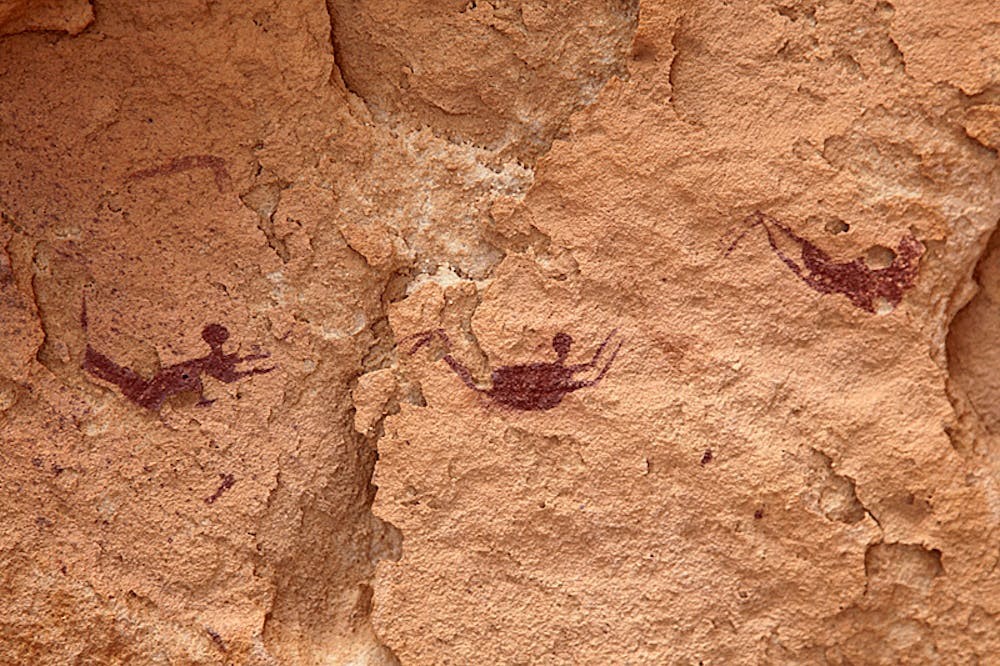Swimming, a seemingly simple act, holds a complex and fascinating history. While most of the world’s population can’t swim today, our earliest ancestors took to the water with confidence over 100,000 years ago. This article explores the intriguing journey of how humans learned to swim, tracing its evolution through time, cultures, and societal shifts.
A painting of swimmers in the Cave of the Swimmers, Wadi Sura, Western Desert, Egypt. Wikimedia Commons
The Dawn of Aquatic Humanity
Evidence suggests that Neanderthals, residing in Italy around 100,000 years ago, were proficient swimmers. Their ear bones bear the telltale signs of “swimmer’s ear,” indicating frequent diving for clamshells used to craft tools. This early mastery of swimming highlights its crucial role in survival, providing access to food sources and potentially aiding in navigation.
The Ice Age and a Shift Away from Water
The last major Ice Age, approximately 23,000 years ago, brought about a dramatic change. Glaciers advanced southward, and swimming, if previously practiced in affected regions, was largely abandoned. This period saw a shift towards agriculture and a decrease in fish consumption, leading to evolutionary changes in skin pigmentation to maximize vitamin D absorption from sunlight. This era marked a significant interruption in the widespread practice of swimming across Eurasia.
The Resurgence of Swimming in Ancient Civilizations
Thousands of years later, rock paintings in Tassili n’Ajjer, southern Algeria, depict figures in horizontal postures with outstretched arms, hinting at a possible resurgence of swimming. By 8000 BCE, the Cave of Swimmers in western Egypt showcases vivid red figures engaged in aquatic activities, providing concrete evidence of swimming’s return.
An ancient Egyptian kohl spoon in the shape of a swimmer. The Louvre/Wikimedia Commons
Egyptian civilization, by 3000 BCE, embraced swimming wholeheartedly. Hieroglyphics and imagery depict swimming as a common practice among royalty and commoners alike, suggesting its integration into daily life and leisure. The overarm stroke, still taught today, is the oldest depicted swimming technique, appearing in Egyptian, Hittite, and early Greek and Roman art.
Cultural and Societal Influences on Swimming
Swimming wasn’t universally practiced in the ancient world. Across Europe and northern Asia, fear of water and its mythical inhabitants prevailed. Cultural differences played a significant role, with some cultures associating swimming with specific racial or social groups. The ability to swim, or lack thereof, became a marker of identity and even class distinction.
The Dark Side of Swimming’s History
Swimming’s history is intertwined with darker aspects of human society. It was often linked to sexuality and promiscuity, appearing in myths and literature as a prelude to seduction or violence. The practice of “trial by water” for suspected witches further demonstrates the negative connotations associated with swimming, particularly for women. The history of slavery also reveals a complex relationship with swimming, where enslaved individuals were forced to utilize their aquatic skills for labor while simultaneously facing dehumanization based on those very abilities.
J. Wesley Van der Voort, Pearl Divers at Work, 1883. University of Washington/Wikimedia Commons
Swimming Today: An Elite Pastime?
From essential survival skill to a leisure activity, the evolution of swimming reflects the complex interplay of human history, culture, and societal structures. Today, the inability to swim is prevalent globally, raising questions about access, equity, and the legacy of historical biases. Has swimming truly become a pastime of the elite, as some scholars suggest? The answer lies in understanding the deep-rooted history of how humans learned to swim and the forces that shaped its trajectory through time. The journey from the first tentative strokes of our ancestors to the complex relationship we have with water today is a testament to the enduring power of cultural and societal forces in shaping human behavior.
